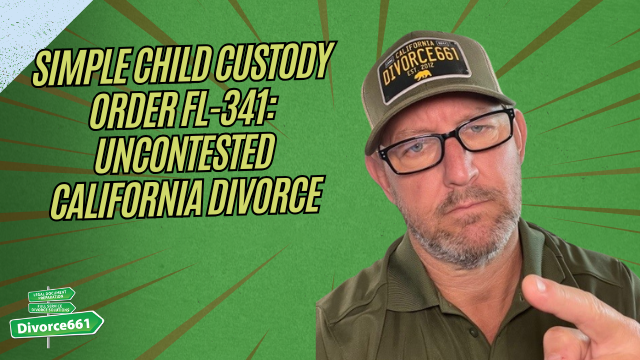SIMPLE Child Custody Order FL-341: Uncontested California Divorce
Navigating the child custody process during a divorce can often feel overwhelming, especially when faced with lengthy and complicated legal forms. However, when it comes to completing the SIMPLE Child Custody Order FL-341 in an uncontested California divorce, the process is much simpler than it appears. Understanding exactly what to mark on this form can save you time and avoid unnecessary confusion.
Understanding the FL-341 Child Custody Order Form
The FL-341 form is designed to outline custody arrangements between parents in California. Although the form itself may span several pages and present multiple options, it’s important to focus on the essentials. When submitting your judgment in an uncontested divorce, you only need to mark three key options:
- Joint Legal Custody
- Joint Physical Custody
- Reasonable Right of Visitation
Marking these options accurately reflects the typical custody arrangement in many uncontested divorces, where both parents share legal and physical responsibilities for their child and reasonable visitation rights are established.
Why Only These Three Options?
While the FL-341 form includes four pages of possible choices and checkboxes, many of these are more applicable to contested custody cases or situations requiring detailed specifications. In uncontested divorces, simplifying the process helps avoid delays and streamlines court approval.
By focusing solely on joint legal custody, joint physical custody, and reasonable visitation rights, parents clearly communicate the shared responsibilities and access arrangements without overcomplicating the judgment. This approach aligns with the goal of uncontested divorces: reaching an amicable agreement that serves the best interests of the child efficiently.
What Do These Terms Mean?
Joint Legal Custody
This means both parents share the right to make important decisions about their child’s upbringing, including education, healthcare, and religious training. Joint legal custody emphasizes cooperation and communication between parents.
Joint Physical Custody
Joint physical custody means the child spends significant time living with both parents. This arrangement ensures the child maintains a strong relationship with each parent and benefits from their involvement in daily life.
Reasonable Right of Visitation
Even with joint physical custody, establishing a reasonable visitation schedule is crucial. This ensures that both parents have fair and consistent access to the child, which supports stability and routine for everyone involved.
Final Tips for Completing Your Custody Judgment
- Keep the process straightforward by only marking the three essential boxes.
- Double-check that your selections reflect the actual custody agreement between you and the other parent.
- Consult with a family law professional if you have questions or if your situation involves complexities beyond a standard uncontested divorce.
Remember, the goal is to create a clear, concise custody order that the court can approve quickly, helping you move forward with your divorce and focus on what matters most: the well-being of your child.
Conclusion
Completing the SIMPLE Child Custody Order FL-341 form doesn’t have to be complicated. By concentrating on marking joint legal custody, joint physical custody, and reasonable visitation rights, you simplify the process and help ensure your custody judgment is accepted without unnecessary delays. This straightforward approach is ideal for uncontested California divorces and supports a cooperative parenting arrangement.
For anyone navigating this process, keeping it simple is the key to success.


